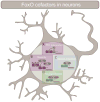Keeping Neurons Young and Foxy: FoxOs Promote Neuronal Plasticity
- PMID: 29102406
- PMCID: PMC5741477
- DOI: 10.1016/j.tig.2017.10.002
Keeping Neurons Young and Foxy: FoxOs Promote Neuronal Plasticity
Abstract
Any adult who has tried to take up the piano or learn a new language is faced with the sobering realization that acquiring such skills is more challenging as an adult than as a child. Neuronal plasticity, or the malleability of brain circuits, declines with age. Young neurons tend to be more adaptable and can alter the size and strength of their connections more readily than can old neurons. Myriad circuit- and synapse-level mechanisms that shape plasticity have been identified. Yet, molecular mechanisms setting the overall competence of young neurons for distinct forms of plasticity remain largely obscure. Recent studies indicate evolutionarily conserved roles for FoxO proteins in establishing the capacity for cell-fate, morphological, and synaptic plasticity in neurons.
Keywords: Daf-16; FoxO; microtubule dynamics; neurodegeneration; neuronal plasticity; synaptic plasticity.
Copyright © 2017 Elsevier Ltd. All rights reserved.
Figures




Similar articles
-
Homeostatic plasticity in the CNS: synaptic and intrinsic forms.J Physiol Paris. 2003 Jul-Nov;97(4-6):391-402. doi: 10.1016/j.jphysparis.2004.01.005. J Physiol Paris. 2003. PMID: 15242651 Review.
-
The C. elegans adult neuronal IIS/FOXO transcriptome reveals adult phenotype regulators.Nature. 2016 Jan 7;529(7584):92-6. doi: 10.1038/nature16483. Epub 2015 Dec 14. Nature. 2016. PMID: 26675724 Free PMC article.
-
Genome-wide endogenous DAF-16/FOXO recruitment dynamics during lowered insulin signalling in C. elegans.Oncotarget. 2015 Dec 8;6(39):41418-33. doi: 10.18632/oncotarget.6282. Oncotarget. 2015. PMID: 26539642 Free PMC article.
-
FOXO in Neural Cells and Diseases of the Nervous System.Curr Top Dev Biol. 2018;127:105-118. doi: 10.1016/bs.ctdb.2017.10.002. Epub 2018 Feb 3. Curr Top Dev Biol. 2018. PMID: 29433734 Free PMC article. Review.
-
FoxO regulates microtubule dynamics and polarity to promote dendrite branching in Drosophila sensory neurons.Dev Biol. 2016 Oct 1;418(1):40-54. doi: 10.1016/j.ydbio.2016.08.018. Epub 2016 Aug 18. Dev Biol. 2016. PMID: 27546375 Free PMC article.
Cited by
-
Neurogenesis in Caenorhabditis elegans.Genetics. 2024 Oct 7;228(2):iyae116. doi: 10.1093/genetics/iyae116. Genetics. 2024. PMID: 39167071 Free PMC article. Review.
-
Edible Flowers of Tagetes erecta L. as Functional Ingredients: Phenolic Composition, Antioxidant and Protective Effects on Caenorhabditis elegans.Nutrients. 2018 Dec 18;10(12):2002. doi: 10.3390/nu10122002. Nutrients. 2018. PMID: 30567311 Free PMC article.
-
Modulating FOXO3 transcriptional activity by small, DBD-binding molecules.Elife. 2019 Dec 4;8:e48876. doi: 10.7554/eLife.48876. Elife. 2019. PMID: 31789593 Free PMC article.
-
Activation of angiotensin-converting enzyme 2/angiotensin (1-7)/mas receptor axis triggers autophagy and suppresses microglia proinflammatory polarization via forkhead box class O1 signaling.Aging Cell. 2021 Oct;20(10):e13480. doi: 10.1111/acel.13480. Epub 2021 Sep 16. Aging Cell. 2021. PMID: 34529881 Free PMC article.
-
FOXO Regulates Neuromuscular Junction Homeostasis During Drosophila Aging.Front Aging Neurosci. 2021 Jan 27;12:567861. doi: 10.3389/fnagi.2020.567861. eCollection 2020. Front Aging Neurosci. 2021. PMID: 33584240 Free PMC article.
References
-
- Kenyon C, et al. A C. elegans mutant that lives twice as long as wild type. Nature. 1993;366:461–464. - PubMed
-
- Lin K, et al. daf-16: An HNF-3/forkhead family member that can function to double the life-span of Caenorhabditis elegans. Science. 1997;278:1319–1322. - PubMed
-
- Ogg S, et al. The Fork head transcription factor DAF-16 transduces insulin-like metabolic and longevity signals in C. elegans. Nature. 1997;389:994–999. - PubMed
Publication types
MeSH terms
Substances
Grants and funding
LinkOut - more resources
Full Text Sources
Other Literature Sources
Molecular Biology Databases
Miscellaneous

